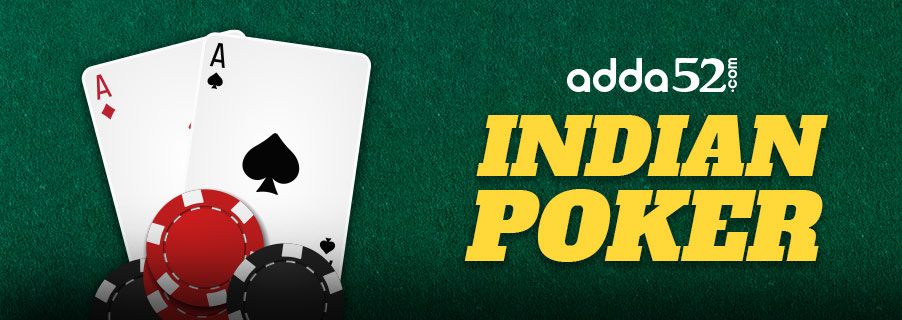Indian Poker

Introduction
If you enjoy card games like Rummy or Texas Holdem, you might like Indian Poker too. It's gaining popularity among card game fans.
Indian Poker mixes traditional poker with strategy and betting, making it simple to pick up but tricky to become a master. In this blog, let's explore the game's rules and basics.
What is Indian Poker
Indian Poker, also known as Blind Man's Bluff, is a card game where players hold a single card facedown on their forehead, allowing all players except themselves to see it.
Each player gets a card face down, so they don't know what it is, but they can see other players' cards. The aim is to guess your card's value by watching how others react and bet. It's more about intuition than strategies.
The objective of the Game
The objective is to guess the highest card in the game. Players rely on their intuition and memory as they need direct visibility of their cards. The player who correctly guesses or has the highest card typically wins the round or the game, depending on the specific rules being followed.
How to play Indian Poker?
To play Indian Poker, follow these steps:
Set-Up
- Each player is dealt one card face down, which they should not look at.
- Players hold their cards against their foreheads so that everyone else can see them, but they cannot see their cards.
- Decide on the betting structure and initial bet amount.
Betting Stage
- Players take turns betting based on their perception of the strength of their card relative to others.
- The betting round continues until all players have called, raised, or folded.
Remember, Indian Poker relies heavily on reading opponents' reactions and making calculated bets based on limited information, as players cannot see their cards.
Card Rankings
In Indian poker card rankings are quite different from traditional poker. Here's how the rankings typically work:
- Highest Card: The highest-ranked card is usually the Ace, followed by the King, Queen, and so on down to the 2. However, in some variations, the lowest card is considered the highest.
- Lowest Card: Conversely, in some variations of Indian Poker, the lowest card is considered the highest-ranking card. In this case, the 2 would be the highest card, followed by the 3, 4, and so forth up to the Ace.
- Special Considerations: In some versions, special considerations may apply. For example, some games may have a "Joker" card that holds a unique ranking or functions as a wildcard.
The specific ranking may vary depending on house rules or player agreement before the game begins. It's essential to clarify the card rankings before starting a game to avoid confusion.
Indian Poker Rules
Here are the basic rules:
- Each player receives one card face-down, which they place on their forehead without looking at it.
- Players make bets based on the strength of their perceived hand, relying on the reactions and bets of others to gauge their own card's value.
- After betting, players reveal their cards, and the player with the highest or lowest card wins, depending on the variant being played.
- Depending on house rules or agreed-upon variations, either the highest or lowest card may win. In some versions, special considerations like joker cards may apply.
Variations of Indian Poker
Here are some notable variations:
- Standard Indian Poker: Players hold their cards against their foreheads, allowing them to see their opponents' cards but not their own. The objective is to have the highest or lowest card, depending on the agreed-upon rules.
- Two-Card Blind Man's Bluff: In this variant, each player receives two cards instead of one. One card is placed on the forehead, visible to others, while the other card remains concealed. This adds complexity to the game and alters betting strategies.
- Adapted from Texas Hold 'em: Some versions of Blind Man's Bluff poker are adapted from Texas Hold 'em. In this adaptation, players get all their cards face-down, and betting follows the standard Texas Hold 'em rules.
- Special Rules for Betting: Variations may include special rules for betting, such as limited betting rounds, fixed bet sizes, or different betting structures to add complexity and excitement to the game.
- Joker Cards: Some versions may introduce joker cards, which can act as wildcards or hold unique values, influencing the gameplay and strategy.
Popularity of Indian Poker
Indian Poker has gained popularity due to its simplicity, suspenseful gameplay, and the unique twist of not knowing your hand. It's often played casually among friends or in poker tournaments.
There are plenty of poker games and tournaments available online, which makes it easy to play anytime and anywhere, which has added to its popularity.
Betting Rounds in Indian Poker Game:
In Indian Poke, the betting rounds follow specific guidelines:
- There is no limit to betting in Indian Poker. Players have the freedom to bet any amount they desire during the betting rounds.
- Unlike some traditional poker variants, Indian Poker typically features only one round of betting. During this round, players must place their bets, and there are no subsequent betting rounds.
- Betting rounds continue until all players have either called, folded, or raised. Once a player raises and all remaining players call their raise, the betting round concludes, and the game progresses.
Tips for Playing Indian Poker:
Here are some tips for playing Indian Poker:
- Familiarise yourself with the rules of the game, including hand rankings and betting structure.
- Pay attention to your opponent's actions and try to discern their playing styles and betting patterns.
- Manage your funds effectively to ensure you can continue playing without risking all your money at once.
- Employ bluffing tactics strategically, but avoid overdoing it as skilled opponents can catch on.
- Continuously study and improve your poker skills by reading, watching tutorials, and analyzing your gameplay.
- Keep your emotions in check and avoid making impulsive decisions driven by frustration or excitement.
Frequently asked questions
What is an Indian Poker?
Indian Poker, also known as Blind Man's Bluff, is a card game where players hold cards facing outward on their foreheads. They aim to deduce the strength of their cards by observing others.
What is the highest-ranking card in Indian poker?
The highest-ranking card in Indian poker is the Ace, while the lowest is the Two. The objective is to hold the highest or lowest card to win the pot.
How do you play Indian in poker?
To play Indian Poker, each player is dealt one card face-down. Players hold their cards on their foreheads without looking. Bet on having the highest-ranked card to win.
Why is it called Indian poker?
The name comes from how people stick cards to their foreheads. In American culture, some think of Native Americans putting a feather on their head as decoration. The cards on players' foreheads remind people of these decorations.
Is online poker legal in India?
The legality of poker online in India is subject to state regulations. Some states consider poker a game of skill and therefore legal, while others classify it as a form of gambling and restrict its operation. It is advisable to check specific laws and regulations of your state regarding online poker before participating.
Conclusion
Indian Poker, or Blind Man's Bluff, offers a refreshing twist on traditional poker, testing players' intuition and psychological prowess.
So gather your friends, sharpen your instincts, and enjoy a fun game of Indian Poker!
